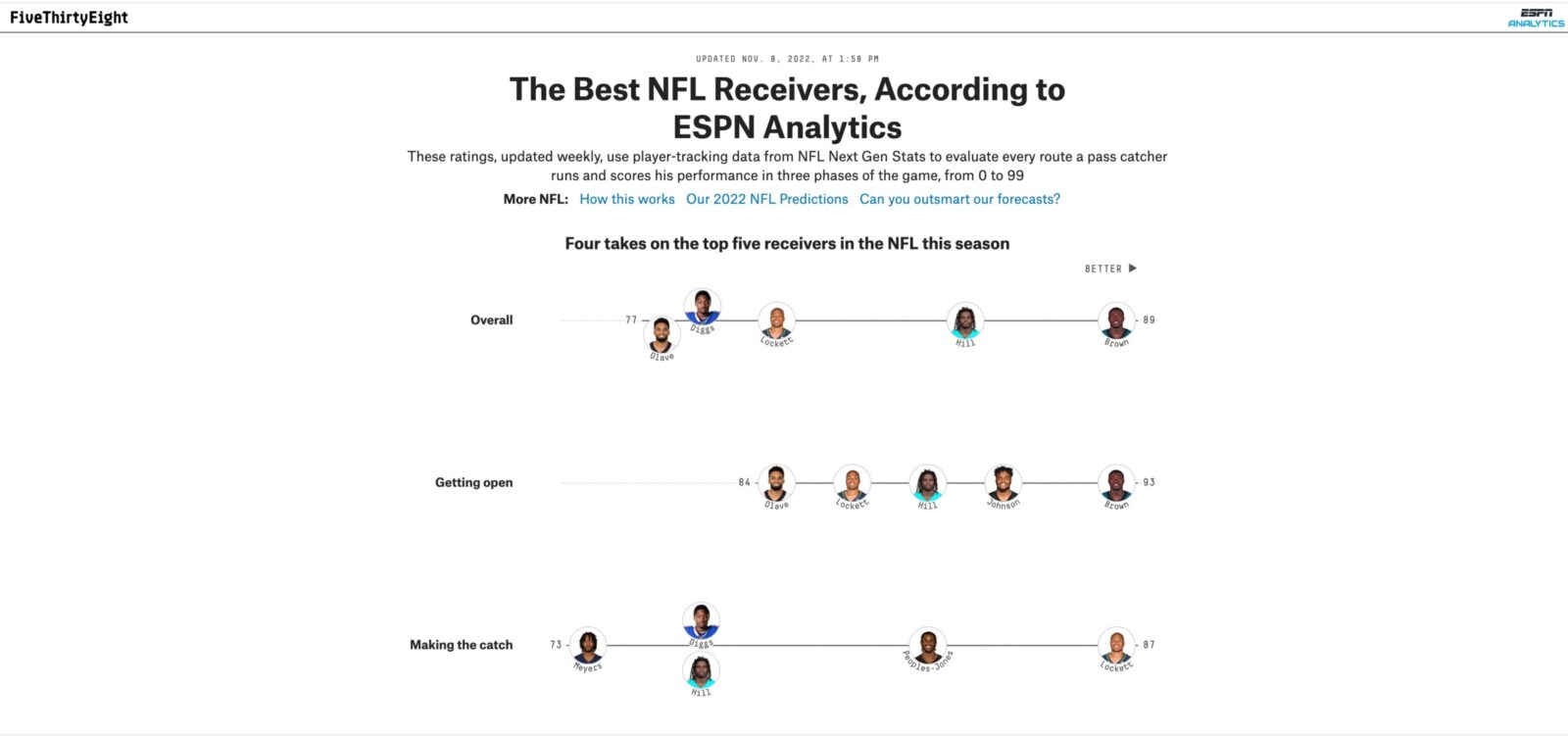ESPN Analytics Debuts New Receiver Tracking Metric On FiveThirtyEight
Why is Philadelphia's A.J. Brown having the best campaign of any NFL wide receiver this season? ESPN Sports Data Scientist Brian Burke explains the importance of the pass-catching metric to the current and future landscape of football
ESPN Analytics continues to drive football into the future.
In collaboration with data-driven news and analysis site FiveThirtyEight, ESPN Analytics has launched an interactive version of its newest groundbreaking metric, NFL Receiver Tracking Metrics (RTMs).

With the integration of advanced player data from NFL Next Gen Stats and the use of innovative machine learning techniques, the Receiver Tracking model analyzes every route to explain how receivers are producing (or why they’re not producing), rather than simply ranking best to worst.
The ratings score performances on a 0-99 scale in three phases: ability to get open, make the catch, and gain yards after catch (YAC). Ratings are updated weekly on Mondays and Tuesdays, and some recent notable stories from the current interactive include:
- Philadelphia Eagles receiver A.J. Brown currently has the best overall score (89) this season.
- Las Vegas Raiders receiver Davante Adams has fallen short from his years in Green Bay. After finishing Top 3 overall in 2020 and 2021, Adams is 37th, tied with Dallas Cowboys receiver Noah Brown and Seattle Seahawks receiver DK Metcalf.
RTMs are the latest in a long line of innovative storytelling metrics from ESPN Analytics that leverage NFL Next Gen Stats, joining Pass Block/Rush Win Rates, Run Block/Stop Win Rates, Receiver Route Classifications, and Defensive Pass Coverage Classifications.
“Receiver Tracking Metrics was a great opportunity to marry a world class metric from ESPN Analytics to FiveThirtyEight’s sophisticated data visualizations, allowing it to get into the hands of fans,” said Allison Loucks, ESPN Director of Business Development & Innovation. “We hope this is the first of many collaborations with FiveThirtyEight.”
What differentiates RTMs from those is how accessible it is to the fans through the FiveThirtyEight interactive. Front Row caught up with ESPN Sports Data Scientist Brian Burke to learn more about RTMs and their importance to the current and future landscape of football.

(Melissa Rawlins/ESPN Images)
What prompted you to create this metric? How did it all come together?”
Football has long been known as the ultimate team sport, so it has always been a challenge to isolate and quantify an individual player’s impact apart from the other 21 players on the field.
The advent of tracking data has allowed us to do that in many ways, and now fans can see a complete picture of a receiver’s play by evaluating every route.
This metric all came together in a single eureka moment after working on the project off and on for almost two years. We stumbled upon a way to measure how a receiver influenced the defenders on a play, above and beyond what would be expected by a typical receiver running the same route against the same coverage. Once we cracked that nut, everything else fell into place.
What do you think is the most important part of RTMs, and for what audience?
The most important thing is the story we can tell about every receiver using those three components (ability to get open, make the catch, and generate YAC). The components of this explain how receivers are producing or why they’re not producing.
Because RTMs are relatively steady from season to season, they are predictive, so they will be useful to a variety of fan segments such as fantasy sports, betting, and casual fans alike.
Is there anything else you’d like to add?
We learned a lot along the way in the development of RTMs, some of which include beating man coverage is a key ability among top receivers (more than zone coverage) and that quarterbacks have an impact across all three of the aforementioned components.
Kansas City Chiefs quarterback Patrick Mahomes is a great example. He is no more accurate than a typical NFL starter, but he has an uncanny ability to make his receivers be more open than would otherwise be expected – presumably by extending plays, making the right reads, and looking-off defenders in coverage.
ESPN Analytics produced the video above featuring ESPN Analytics Writer Seth Walder








